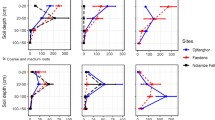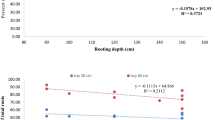Abstract
Slope is a complex environmental factor that can subject plants to a number of mechanical stresses. The anchorage of roots and improvement of slope stability mainly depend on specific properties of root systems, such as root distribution. In the present study, 24 trees (from three species) growing on gentle slopes (10–20°) were randomly chosen for root distribution analysis. The profile trenching method was used to obtain root characteristics. The findings indicated that root area ratio (RAR) decreased with depth and that maximum RAR values were observed in the upper layers; RAR values were between 0.0004% and 6.6444%. Average RAR values were not statistically different in upslope and downslope layers except in one case. The dot grid method (100 × 150 mm) usually overestimated the RAR values. The amount of roots decreased with depth following a power law. About 50% and 90% of roots were located in the first 30 and 60 cm depths, respectively. Results of analysis of covariance (ANCOVA) showed a significant effect of diameter at breast height (DBH) on total RAR but not on the total number of roots. About 70% of roots had diameter of less than 10 mm. Spearman’s correlation showed significant negative correlation between the total number of roots and the amount of N, P, and K elements, and a positive correlation between DBH and RAR. The results serve to develop understanding of the biotechnical characteristics of root systems of Caspian species.


Similar content being viewed by others
References
Abernethy B, Rutherfurd D (2000) The effect of riparian tree roots on the mass-stability of riverbanks. Earth Surf Proc Land 25:921–937
Abernethy B, Rutherfurd D (2001) The distribution and strength of riparian tree roots in relation to riverbank reinforcement. Hydrol Process 15:63–79
American Society for Testing and Materials (1992) Annual Book of ASTM Standards, vol 04.08. ASTM, Philadelphia, PA
Bibalani GH (2001) Effect of some tree species on slope stability. PhD thesis, Islamic Azad University, Tehran, Iran (in Persian)
Bischetti GB, Chiaradia EA, Simonato T, Speziali B, Vitali B, Vullo P, Zocco A (2005) Root strength and root area ratio of forest species in Lombardy (Northern Italy). Plant Soil 278:11–22
Bohm W (1979) Methods of studying root systems. Springer-Verlag, Berlin, p 188
Burke MK, Raynal DJ (1994) Fine root growth phenology, production and turnover in a northern hardwood forest ecosystem. Plant Soil 162:135–146
Canadell J, Roda F (1991) Root biomass of Quercus ilex in a mountain mediterranean forest. Can J For Res 21:1771–1778
Chiaradia EA, Bischetti GB (2004) Estimation of the effect of forest on soil slip phenomena by means of a spatially distributed model. In: Conference “The use of vegetation to improve slope stability”, Thessaloniki, Greece, 13–17 September 2004
Chiatante D, Scippa GS, Di Iorio A, Sarnataro M (2001) The stability of trees growing on slope depends upon a particular conformational structure imposed by mechanical stress in their root system. In: Radoglou K (ed) Proceedings of the International Conference: Forest Research: a challenge for an integrated European approach. Thessaloniki, Greece, pp 477–482
Chiatante D, Sarnataro M, Fusco S, Di Iorio A, Scippa GS (2003a) Modification of root morphological parameters and root architecture in seedlings of Fraxinus ornus L. and Spartium junceum L. growing on slopes. Plant Biosyst 137:47–56
Chiatante D, Scippa GS, Di Iorio A, Sarnataro M (2003b) The influence of steep slope on root system development. J Plant Growth Regul 21:247–260
Coutts MP, Nicoll BC (1991) Orientation of the lateral roots of trees. Upward growth of surface roots and deflection near the soil surface. New Phytol 119:227–234
Coutts MP, Nielsen CCN, Nicoll BC (1999) The development of symmetry, rigidity and anchorage in the structural root system of conifers. Plant Soil 217:1–15
Das BM (2005) Fundamentals of geotechnical engineering, 2nd edn. Nelson publications, 566p
Di Iorio A, Lasserre B, Scippa GS, Chiatante D (2005) Root system architecture of Quercus pubescens trees growing on different sloping conditions. Ann Bot 95:351–361
Fitter AH (1991) Characteristics and functions of root systems. In: Waisel Y, Eshel A, Kafkafi U (eds) Plant roots: the hidden half. Marcel Dekker, New York, pp 3–25
Ganatsas P, Spanos P (2005) Root system asymmetry of Mediterranean pines. Plant Soil 278:75–83
Gartner BL (1994) Root biomechanics and whole-plant allocation patterns: responses of tomato plants to stem flexure. J Exp Bot 280:1647–1654
Goodman AM, Ennos AR (1996) A comparative study of the response of the roots and shoots of sunflower and maize to mechanical stimulation. J Exp Bot 47:1499–1507
Goodman AM, Ennos AR (1997) The responses of field-grown sunflower and maize to mechanical support. Ann Bot 79:703–711
Goodman AM, Ennos AR (1999) The effects of soil bulk density on the morphology and anchorage mechanics of the root systems of sunflower and maize. Ann Bot 83:293–302
Gray DH, Leiser AT (1982) Biotechnical slope protection and erosion control. Van Nostrand Reinhold, New York, p 271
Greenway DR (1987) Vegetation and slope stability. In: Anderson MG, Richards KS (eds) Slope stability. Wiley, Chichester, pp 187–230
Greenwood JR, Norris JR, Wint JO (2006) Site investigation for the effects of vegetation on ground stability. Geotech Geol Eng 24:467–481
Jackson RB, Canadell J, Ehleringer JR, Mooney HA, Sala OE, Shulze ED (1996) A global analysis of root distribution for terrestrial biomes. Oecologia 108:389–411
Jafari M (2004) Methods of soil analysis, 1st edn. pp 167–205 (in Persian)
Jaffe MJ (1973) Thigmomorphogenesis: the response of plant growth and development to mechanical stimulation. Planta 114:143–157
Lyford WH (1980) Development of the root system of northern red oak (Quercus rubra L.). Harward Forest Paper 21, Petersham, p 30
Majnounian B, Etter H (1993) Kheirud forest management revision plan. Iran J Nat Res Special issue: 1–102 (In Persian)
Makarova OV, Cofie P, Koolen AJ (1998) Axial stress–strain relationships of fine roots of Beech and Larch in loading to failure and in cyclic loading. Soil Till Res 45:175–187
McGeehan SL, Naylor DV (1988) Automated instrumental analysis of carbon and nitrogen in plant and soil samples. Commun Soil Sci Plant Anal 19:493–505
Morgan RP, Rickson RJ (1995) Slope stabilization and erosion control—a bioengineering approach. Chapman and Hall, University Press, Cambridge
Nicoll BC, Ray D (1996) Adaptive growth of tree root systems in response to wind action and site conditions. Tree Physiol 16:891–898
Nilaweera NS (1994) Effects of tree roots on slope stability: the case of Khao Luang Mountain area, So Thailand. Dissert. No. Gt-93-2
Normaniza O, Faisal HA, Barakbah SS (2008) Engineering properties of Leucaena leucocephala for prevention of slope failure. Ecol Eng 32:215–221
Norusis MJ (2002) SPSS 15.0 Guide to data analysis. Prentice Hall, 637p
Olsen SR, Sommers LE (1982) Phosphorus. In: Page AL, Miller RH, Keeney DR (eds) Methods of soil analysis. Part 2, 2nd edn. Agronomy No. 9. American Society of Agronomy, Madison, pp 403–430
Quine CP, Burnand AC, Coutts MP, Reynard BR (1991) Effect of mounds and stumps on the root architecture of Sitka spruce on a peaty gley restocking site. Forestry 64:385–401
Saeed A (1994) Fundamentals of practical economics in forest management, 1st edn. Tehran University Press, Tehran, 207p (in Persian)
Schmid I, Kazda M (2001) Vertical distribution and radial growth of coarse roots in pure and mixed stands of Fagus sylvatica and Picea abies. Can J For Res 31:539–548
Schmidt KM, Roering JJ, Stock JD, Dietrich WE, Montgomery DR, Schaub T (2001) The variability of root cohesion as an influence on shallow landslide susceptibility in the Oregon Coast Range. Can Geotech J 38:995–1024
Shields FD, Gray DH (1993) Effects of woody vegetation on sandy levee integrity. Water Resour Bull 28:917–931
Simon A, Collison AJC (2002) Quantifying the mechanical and hydrologic effects of riparian vegetation on streambank stability. Earth Surf Proc Land 27:527–546
Stokes A, Fitte AH, Coutts MP (1995) Responses of young trees to wind and shading: effects on root architecture. J Exp Bot 46:1139–1146
Stokes A, Nicoll BC, Coutts MP, Fitter A (1997) Responses of young Sitka spruce clones to mechanical perturbation and nutrition: effects on biomass allocation, root development and resistance to bending. Can J For Res 27:1049–1057
Stokes A, Norris JE, van Beek LPH, Bogaard T, Cammeraat E, Mickovski SB, Jenner A, Di Iorio A Fourcaud T (2008) How vegetation reinforces the soil on slopes. In: Norris J, Stokes A, Mickovski SB, Cammeraat E, Van Beek R, Nicoll BC, Achim A (eds) Slope stability and erosion control: ecotechnological solutions. Springer, New York, pp 65–118
Sun HL, Li SC, Xiong WL, Yang ZR, Cui BS, Yang T (2008) Influence of slope on root system anchorage of Pinus yunnanensis. Ecol Eng 32:60–67
Tsukamoto Y, Kusakaba O (1984) Vegetation influences on debris slide occurrences on steep slopes in Japan. Paper presented to symposium on effects of forest land use on erosion and slope stability. Honolulu, Hawaii
Wu TH, McKinnell WP, Swanston DN (1979) Strength of tree root and landslides on Prince of Wales Island, Alaska. Can Geotech J 16:19–33
Zhou Y, Watts D, Li Y, Cheng X (1998) A case study of effect of lateral roots of Pinus yunnanensis on shallow soil reinforcement. For Ecol Manage 103:107–120
Zobeiri M (2000) Forest inventory, 2nd edn. Tehran University Press, Tehran, 401p (in Persian)
Acknowledgments
This work was supported by the University of Tehran. Prof. Alex Watson is thanked for his supportive comments and reviews during the preparation of this paper, and the kind help of Matt Sakals in reviewing and improving the English of the paper is also appreciated. The authors also express their sincere appreciation to the two anonymous reviewers for their helpful and detailed comments and suggestions.
Author information
Authors and Affiliations
Corresponding author
About this article
Cite this article
Abdi, E., Majnounian, B., Rahimi, H. et al. A comparison of root distribution of three hardwood species grown on a hillside in the Caspian forest, Iran. J For Res 15, 99–107 (2010). https://doi.org/10.1007/s10310-009-0164-2
Received:
Accepted:
Published:
Issue Date:
DOI: https://doi.org/10.1007/s10310-009-0164-2




